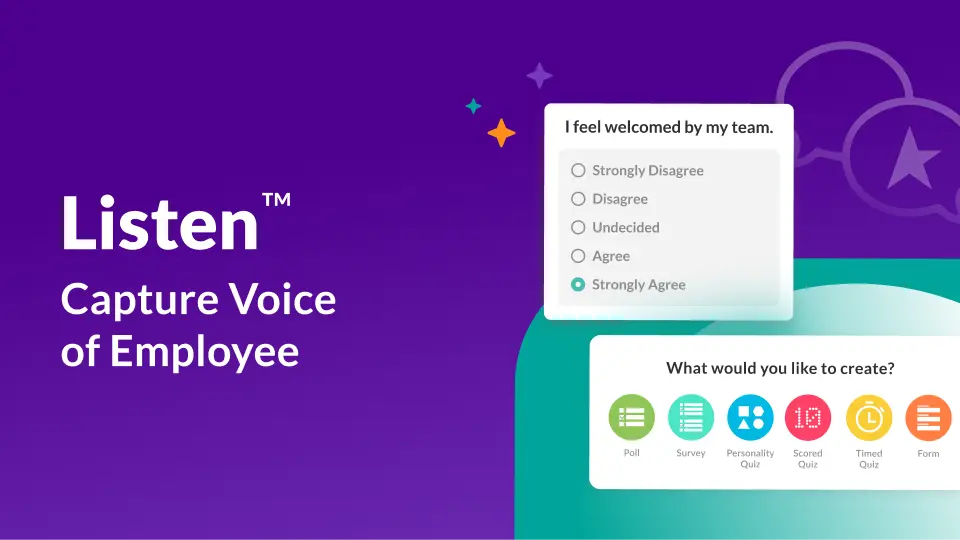Table of contents
Pulse surveys are a crucial tool for understanding how your employees really feel, which is why coming up with the right pulse survey questions is key to giving employees a voice so they can identify and address issues before it’s too late.
As a quick and easy way to solicit feedback anonymously, pulse surveys offer the opportunity for employees to express themselves freely. In fact, 77% of employees are more likely to be honest when responding to a survey than talking to their manager. More focused and concise than traditional annual surveys, pulse surveys are intended to keep tabs on your team’s ever-evolving engagement levels so your company can act as needed.
What are pulse survey questions?
Pulse survey questions are designed to gather regular feedback from employees on specific areas of their work experience, such as their sentiments on their role, manager, teammates, and company culture Unlike traditional annual or quarterly surveys, pulse surveys are conducted more frequently (weekly, bi-weekly, or monthly) in order to provide real-time insights into an employee’s engagement levels and job satisfaction across the board.
Open-ended questions are useful when crafting pulse survey questions, because they allow respondents to freely express their thoughts, experiences, and feelings without the constraints of predetermined choices. Typically beginning with words like “how,” “why,” or “what,” these questions encourage respondents to provide detailed insights, offering a deeper understanding into their opinions and motivations.
How many questions should a pulse survey have?
Pulse surveys should be easy to complete and are typically concise and focused, ranging from 5-15 easy-to-answer questions. While it may be tempting to add more questions and make the survey more comprehensive, it could decrease the number and quality of responses.
Keeping surveys short and sweet helps with gathering actionable insights without overwhelming respondents. It requires a delicate balance between not asking too many questions — which may lead to lower response rates and survey fatigue — while ensuring enough is asked to gather adequate data.
How do you conduct a pulse survey?
To conduct a pulse survey effectively, start by choosing questions that support your company goals while considering the overall employee experience, such as communication, leadership, company culture, wellness, work-life balance, and so forth.
Some tips to consider when coming up with pulse survey questions are:
- Keep your question format consistent: This will provide a dependable method to track overall engagement trends over time and assess how effective the actions that were taken to make improvements were.
- Be upfront with employees on the survey’s purpose: Let them know that you seek their input on changes that were recently implemented, or general feedback on job satisfaction.
- Ensure questions are easy to understand: Tailoring your pulse survey questions to employees will decrease the chance of skipped or randomly selected answers (which may lead to inaccurate results).
- Improve your process: Make sure to continuously review your pulse survey creation process based on employee feedback, whether it’s adjusting the questions, methodology, and frequency.
- Incorporate a chatbot: You can also supplement your pulse survey with a chatbot, an alternate way for employees to provide frequent feedback via confidential conversations.
Employee pulse survey questions examples
Pulse questions that are engagement indicators
Let’s start with the three primary indicators of engagement: enthusiasm, commitment, and advocacy. These questions are intended to paint a picture of the current level of employee engagement at your organization.
1. Enthusiasm
- I am always excited to head to work
- I feel motivated to do my best work in this role
- I often feel energized at work
- I feel challenged and energized by the work I do
Engaged employees are enthusiastic and motivated, so this is a question you should include in all your pulse surveys. If it shows low levels of excitement among employees, implement initiatives to reverse this trend. Beyond continuing to solicit and act on employee feedback, starting a recognition program, empowering your team, and focusing on company culture are all great ways to boost enthusiasm and engagement among your workforce.
2. Advocacy
- I would recommend this company as a great place to work
- I feel like the company has my best interests at heart
- I would suggest working at this company to friends
One of the clearest signs of whether an employee intends to stay with your company long-term is if they’re willing to recommend it to a friend. Employee referrals can be your most valuable hiring channel, so consider implementing a formal employee referral program. If employees aren’t willing to recommend your company, they’ve got one foot out the door. Take steps to improve aspects of the employee experience that impact retention, like providing a clear path for career growth and development.
3. Commitment
- I see myself here a year from now
- I plan on remaining with this company for the foreseeable future
- I would stay with this company even if I was offered a job with another organization
Employees who don’t see a future with your company are unlikely to give their all day-in and day-out. If responses to this question lean negative, ensure your organization is doing all it can to boost employee retention, from supporting professional development to establishing clear career paths.
Pulse questions that are engagement indicators
Recognition
- The recognition I receive makes me feel valued at work
- I feel that I receive enough recognition from my manager
- The recognition I receive is meaningful and relevant
- I receive recognition in a timely manner
Employees who feel appreciated stick around and give their all. Employees who go unrecognized don’t. Recognition has a demonstrated positive effect on motivation and engagement.
If most employees respond affirmatively to this question, your recognition program is on the right track. If they don’t, explore new ways to provide employee recognition, and consider adopting an employee recognition platform to make showing appreciation as easy as possible.
You might also consider asking employees whether they’re satisfied with the incentives your organization offers. Implementing great employee incentive programs is an excellent way to demonstrate appreciation tangibly, and improving your incentives doesn’t have to break the bank.
After getting a picture of where engagement stands now, your company should dedicate the majority of its pulse survey to the factors that drive engagement.
Morale pulse questions
Purpose
- I find my job meaningful
- I feel like my work has an impact on the organization
- I find my work fulfilling and purposeful
- I feel connected with the values and missions of this company
Without a meaningful set of company values that support a mission they can believe in, it’s more difficult for employees to stay motivated. Your organization should develop a vision that is clear and compelling, communicate it throughout the company, and ensure that everyone, from leadership on down, acts in alignment with your organization’s values.
Empowerment
- I have the support and resources I need to succeed at work every day
- I am offered opportunities to develop and learn new skills
- I feel that my manager is invested in my personal career goals
- I feel empowered to succeed in this role
Even the most engaged employee is likely to become disillusioned if their best efforts are routinely frustrated by factors outside their control. From training employees on the skills they need, to ensuring they know that management has their back, to simply implementing the processes required for success, there are many ways your organization can empower employees to thrive.
Feedback
- I feel comfortable providing honest feedback regarding my work experience
- I feel that employee feedback is valued and acted upon
- I feel comfortable speaking up and providing feedback to my manager
- I trust that improvements will be made after I give my feedback
This may be the most critical question in any pulse survey, as without it, you’ll have no idea whether you can trust that the results are accurate. You need to cultivate an environment of psychological safety so employees can confidently express their true feelings. Focus on things like building trust and inclusivity, and your employees will repay you with valuable insights.
Work life balance questions
Expectations
- The expectations of me at work are reasonable and easily understood
- My manager communicates expectations and goals clearly
- I feel comfortable taking short breaks during working hours
Asking employees to do more than they can — or failing to clearly communicate exactly what they’re expected to do — is a fast track to burnout and turnover. If employees indicate that they have problems with work expectations, your organization needs to respond.
Evaluate the requirements placed on each role and employee carefully, adjust as needed to match reality, then communicate them to all team members. Keep tailoring responsibilities and expectations as required until everyone knows exactly what they’re expected to accomplish and are confident they can do so.
Manager support
- My manager gives me what I need to succeed
- I feel that management is approachable and accessible
- My manager offers mentorship and coaching in my role
- I have a great working relationship with my manager
The impact of leadership on engagement carries on all the way to the managerial level, and managers should listen when employees speak, especially when their feedback concerns managers themselves. HR professionals should help management transition to a supportive, coaching approach, which can go a long way towards improving the relationship between managers and their direct reports.
Professional development pulse survey questions
Professional development
- I am satisfied with the available opportunities for professional development
- The opportunities for growth with this company align with my career goals
- I have access to mentorship and coaching programs with this company
Providing a clear career path for all employees and giving them the resources and chances they need to succeed and develop is a no-brainer, but many organizations still fail to do so. If your pulse survey shows that employees feel that they’re at a dead end professionally, you should attack the problem from multiple angles. Implement coaching and mentoring programs, empower employees with more autonomy, new responsibilities, and provide internal and external training opportunities at all levels.
Role
- I’m well-suited to my current role in the organization
- My current role is an accurate reflection of how it was described to me
- I feel a sense of belonging with this company and in this role
A lack of fit between a team member and their role at your company can be indicative of many things. It may point to cultural differences, issues with your organization’s hiring and onboarding processes, or problems involving less-than-appealing career paths. Better aligning employee desires and existing roles should be a priority if answers to this question aren’t what your company expects.
Pulse survey questions about the company
Culture
- I feel that our culture is a good fit for me
- I feel connected with the culture that this company is fostering
- I resonate with the company’s mission and values
- I’m satisfied with the company’s efforts to align their values with action
Employee alignment with your culture and values is the foundation for any organization’s success. It’s the number one predictor of engagement in our new normal. Employees appreciate the authenticity shown by companies whose values and actions align, so a lack of alignment between your organization and its values means that you’ll need to take a careful look to determine where the business is falling short. Start by examining your values and taking steps to build a healthier culture.
Leadership
- I trust my leadership team’s vision
- I’m confident in leadership’s capacity to steer the company towards success
- I trust in management’s strategic direction and leadership style
The leaders at your organization, from the C-suite on down, control the direction of your business and set the tone on everything from culture to daily work habits. If they don’t live your organization’s values, champion recognition, and practice transparency in everything they do, employees will take notice. HR should collaborate with leaders by providing necessary training and guidance to help ensure leadership is driving engagement instead of hindering it.
Team relationships
- I can rely on the other members of my tea
- I enjoy collaborating on projects with my teammates
- I feel supported by my teammates and am happy to return the favor
- I care about the wellbeing of my teammates
Team members with genuine, strong relationships help each other and the organization in countless ways. You can’t force your team members to automatically trust each other, but you can create the right circumstances for relationships to thrive organically. By practicing the recommendations above, you’ll be able to strengthen the bonds that bind your company together.
Wellness
- I have been able to maintain a healthy work-life balance
- I’m satisfied with the wellness policies this company has put in place
- I feel that I have enough energy after work to enjoy my life
- I’m able to take short breaks throughout every workday
Work-life balance is a key part of employee wellness, the measure of employees’ physical and emotional health. Burnout is on the rise, and wellness is a key part of keeping it at bay. Implement wellness initiatives like promoting mindfulness and fostering a healthy work environment, if the answers to this question and others like it are negative.
Some examples of company wellness policies and programs include:
- Flexible work setup: Remote work, compressed work weeks, recharge days, and flexible work hours are several ways to combat burnout and improve work-life balance
- Fitness initiatives: Company-wide wellness challenges and gym membership discounts are a couple ways to prioritize physical health at your organization
- Mental health support: Give access to counselling services that are confidential to support employees that struggle with work-related stress and anxiety
- Benefits to support mental health: Ensure that your benefits program covers mental health support, including therapy sessions
- Wellness-focused education: Run in-person or online educational sessions on mental health awareness, how to reduce stress, mindfulness techniques — and give discounts to meditation apps
Respond to feedback from pulse survey questions
So you’ve got your pulse survey questions, what’s next? After carrying out your pulse survey, you need to analyze the data you’ve collected and create an action plan for responding to any issues you identify. Some data, like responses to the questions above, are easy to measure. However, don’t neglect reviewing comments — which you should allow employees to leave in response to most or all questions — as these provide valuable insights that supplement the quantitative data.
This is all much simpler with a platform that lets you easily drill down into the results and discover the key engagement drivers for employees in your organization, so you can focus your resources accordingly. It should break down data using intuitive dashboards and reports and allow you to export results to share. Beyond analysis, the platform must help guide you from analysis to action by giving you the tools you need to build a collaborative action plan with your team.
Achievers Listen offers all this and more. With the ability to easily create and deliver pulse surveys, an always-on employee feedback channel, robust reporting capabilities, and the best Action Builder around, Achievers Listen is the definitive employee engagement solution.




